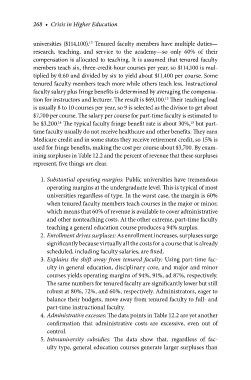Page 298 - Crisis in Higher Education
P. 298
268 • Crisis in Higher Education
13
universities ($114,100). Tenured faculty members have multiple duties—
research, teaching, and service to the academy—so only 60% of their
compensation is allocated to teaching. It is assumed that tenured faculty
members teach six, three-credit-hour courses per year, so $114,100 is mul-
tiplied by 0.60 and divided by six to yield about $11,400 per course. Some
tenured faculty members teach more while others teach less. Instructional
faculty salary plus fringe benefits is determined by averaging the compensa-
13
tion for instructors and lecturer. The result is $69,100. Their teaching load
is usually 8 to 10 courses per year, so 9 is selected as the divisor to get about
$7,700 per course. The salary per course for part-time faculty is estimated to
be $3,200. The typical faculty fringe benefit rate is about 30%, but part-
14
13
time faculty usually do not receive healthcare and other benefits. They earn
Medicare credit and in some states they receive retirement credit, so 15% is
used for fringe benefits, making the cost per course about $3,700. By exam-
ining surpluses in Table 12.2 and the percent of revenue that these surpluses
represent, five things are clear.
1. Substantial operating margins: Public universities have tremendous
operating margins at the undergraduate level. This is typical of most
universities regardless of type. In the worst case, the margin is 60%
when tenured faculty members teach courses in the major or minor,
which means that 60% of revenue is available to cover administrative
and other nonteaching costs. At the other extreme, part-time faculty
teaching a general education course produces a 94% surplus.
2. Enrollment drives surpluses: As enrollment increases, surpluses surge
significantly because virtually all the costs for a course that is already
scheduled, including faculty salaries, are fixed.
3. Explains the shift away from tenured faculty: Using part-time fac-
ulty in general education, disciplinary core, and major and minor
courses yields operating margins of 94%, 91%, ad 87%, respectively.
The same numbers for tenured faculty are significantly lower but still
robust at 80%, 72%, and 60%, respectively. Administrators, eager to
balance their budgets, move away from tenured faculty to full- and
part-time instructional faculty.
4. Administrative excesses: The data points in Table 12.2 are yet another
confirmation that administrative costs are excessive, even out of
control.
5. Intrauniversity subsidies: The data show that, regardless of fac-
ulty type, general education courses generate larger surpluses than

